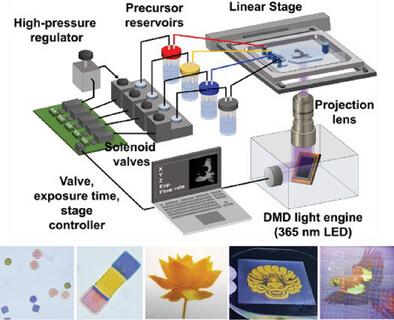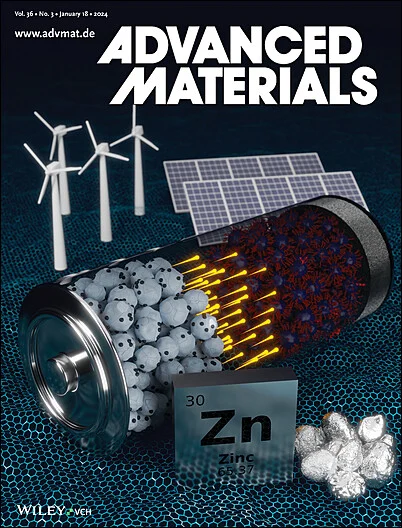High-Throughput Multiplexed Plasmonic Color Encryption of Microgel Architectures via Programmable Dithering-Mask Flow Microlithography
IF 27.4
1区 材料科学
Q1 CHEMISTRY, MULTIDISCIPLINARY
引用次数: 0
Abstract
Silver nanoparticles (AgNPs) are known for their unique plasmonic colors and interaction with light, making them ideal for color printing and data encoding. Traditional methods like electron beam lithography (EBL) and focused ion beam (FIB) milling, however, suffer from low throughput and high costs. In this paper, a scalable and cost-efficient method is introduced for producing multiplexed plasmonic colors by in situ photoreducing AgNPs within microgel architectures with controlled porosity. Utilizing a digital micro-mirror device (DMD)-based flow microlithography system combined with a programmable dithering-mask technique, the high-throughput synthesis of shape or barcoded microparticles is facilitated, along with large-scale, high-resolution images embedded with hidden multiplexed plasmonic colors. This approach allows for a hidden multiplexed plasmonic color code library, significant enhancing the encoding capacity of barcode microparticles from 33 to 303 (a 1000-fold increase). Additionally, quantitative agreement is achieved between chemically encrypted and optically decrypted plasmonic colors using a deep learning classifier. Moreover, the method also supports the production of large scale (>5.6 × 5.6 cm2), high-resolution (>300 dpi) microgel arrays encrypted with multiple plasmonic colors in under 30 min. The multiplexed plasmonic coloration strategy in microgel architectures paves a new way for hidden data storage, secure optical labeling, and anti-counterfeiting technologies.

通过可编程抖动掩膜流式微光刻对微凝胶结构进行高通量多路复用质子颜色加密
银纳米粒子(AgNPs)因其独特的等离子颜色和与光的相互作用而闻名,是彩色印刷和数据编码的理想材料。然而,电子束光刻(EBL)和聚焦离子束铣削(FIB)等传统方法存在产量低、成本高的问题。本文介绍了一种可扩展且具有成本效益的方法,通过在具有可控孔隙率的微凝胶结构中原位光还原 AgNPs 来生产多路复用的质子颜色。利用基于数字微镜设备(DMD)的流动微光刻系统,结合可编程抖动掩膜技术,可以高通量合成形状或条形码微颗粒,并生成嵌入了隐藏式多路复用质子颜色的大规模高分辨率图像。这种方法可实现隐藏式多重质子颜色代码库,将条形码微颗粒的编码能力从 33 个大幅提高到 303 个(提高了 1000 倍)。此外,利用深度学习分类器,在化学加密和光学解密的质子颜色之间实现了定量一致。此外,该方法还支持在 30 分钟内制作出大规模(5.6 × 5.6 平方厘米)、高分辨率(300 dpi)的微凝胶阵列,并使用多种质子颜色进行加密。微凝胶架构中的多重质子着色策略为隐藏数据存储、安全光学标签和防伪技术铺平了新的道路。
本文章由计算机程序翻译,如有差异,请以英文原文为准。
求助全文
约1分钟内获得全文
求助全文
来源期刊

Advanced Materials
工程技术-材料科学:综合
CiteScore
43.00
自引率
4.10%
发文量
2182
审稿时长
2 months
期刊介绍:
Advanced Materials, one of the world's most prestigious journals and the foundation of the Advanced portfolio, is the home of choice for best-in-class materials science for more than 30 years. Following this fast-growing and interdisciplinary field, we are considering and publishing the most important discoveries on any and all materials from materials scientists, chemists, physicists, engineers as well as health and life scientists and bringing you the latest results and trends in modern materials-related research every week.
 求助内容:
求助内容: 应助结果提醒方式:
应助结果提醒方式:


